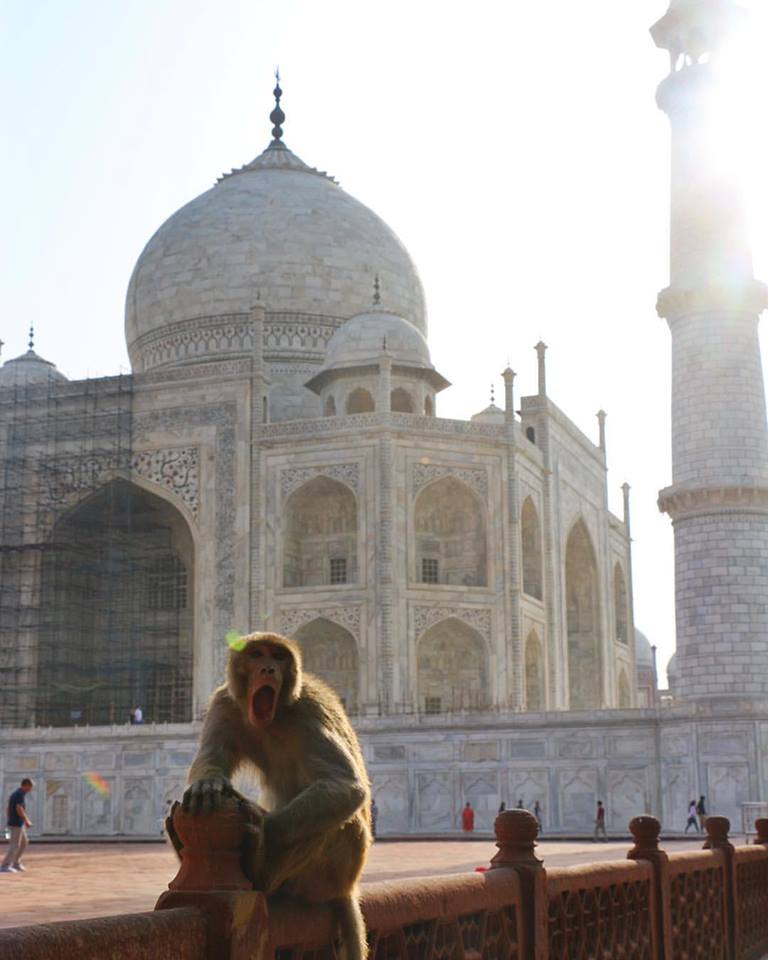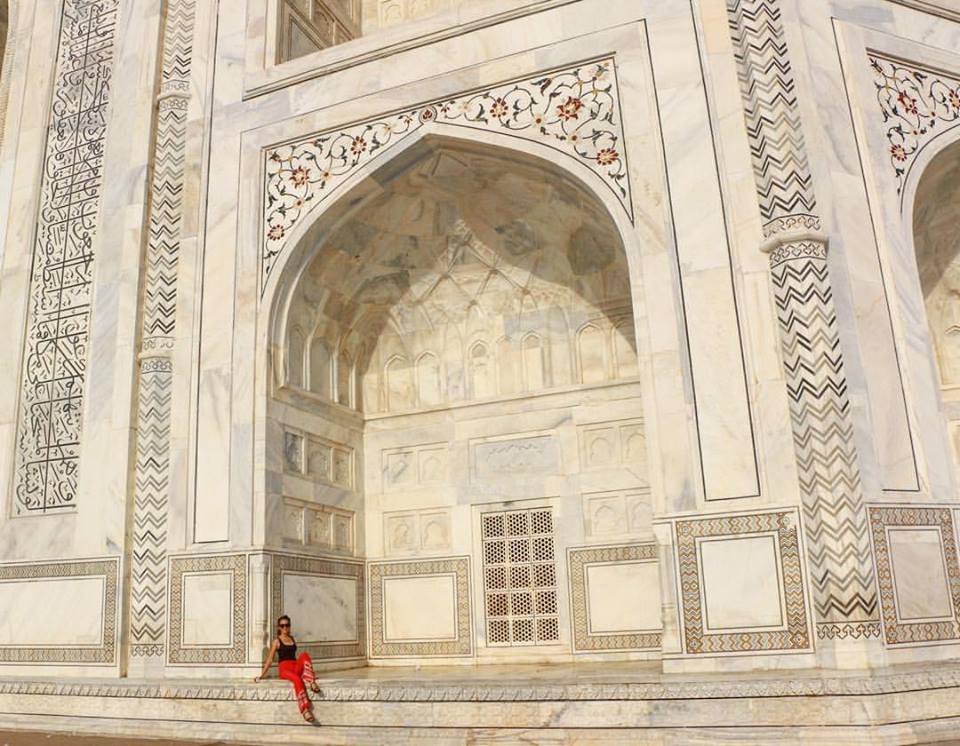India
Sunrise at the Taj Mahal
There are some sunrises that beat all other sunrises. The sunrises that literally leave you speechless in a haze of pink hues and purple rays. The sunrises that remind you why (sometimes) it’s worth getting out of bed earlier.
 Watching the sunrise over the Taj Mahal was one of those ‘I should start getting up earlier’ kind of sunrises.
Watching the sunrise over the Taj Mahal was one of those ‘I should start getting up earlier’ kind of sunrises.
At 4.30am out alarm went off and we set off straight away to buy our tickets to enter the gates of the great Taj Mahal.
Expecting a line and a frustrating process there were only a few other tourists about that morning and before we knew it we had our tickets, complimentary water bottles and ‘plastic shoe covers’ in our hot little hands and were boarding the complimentary shuttle to the great Taj Mahal.
Once again we were expecting some kind of epic wold-wonder preparation line.
Nope. With about 10 people in front of us and only 5 minutes until the gates open we seemed to breeze our way into one of the world’s most beautiful architectural masterpieces.
I always worry about visiting places with automatically high expectations… Will it really look like the photos? Will the crowds make enjoying the view unbearable? Will it be impossible to find a quiet moment alone to sit back and admire?
But I was soon able to put my worries far, far behind me.
 Being off season and very early in the morning, we set eyes on the Taj Mahal with only a few other tourists around. As we walked through the giant arched entrance we had a front-row view of what is without any doubt one of the most beautiful places I have ever visited.
Being off season and very early in the morning, we set eyes on the Taj Mahal with only a few other tourists around. As we walked through the giant arched entrance we had a front-row view of what is without any doubt one of the most beautiful places I have ever visited.
The Taj Mahal is every bit as grand as it looks on postcards. In fact that’s a lie. It is so much grander. Jutting out of the ground so perfectly it honestly looks like a mirage.
Once described by the poet Rabindranath Tagore as ‘a teardrop on the cheek of eternity’; and by Rudyard Kipling as ‘the embodiment of all things pure’ the Taj Mahal is a magical piece of architecture.
After seeing the beauty for myself I can understand why the Taj Mahal is considered the most beautiful building in the world but did not know the romance behind its construction before visiting myself.
The Taj Mahal was constructed by Shah Jahan, a member of the Mughal dynasty that ruled most of northern India from the early 16th to the mid 18th-century. Following his fathers death, King Jahangir, in 1627, Shah Jahan battled for power against his brothers, finally becoming victorious and crowning himself emperor at Agra in 1628.
 Ever by his side was his beloved wide Arjum and Banu Begum, better known as Mumtaz Mahal (“Chosen One of the Palace”), whom he married in 1612 and cherished as the favorite of his three queens.
Ever by his side was his beloved wide Arjum and Banu Begum, better known as Mumtaz Mahal (“Chosen One of the Palace”), whom he married in 1612 and cherished as the favorite of his three queens.
Unfortunately in 1631 Mumtaz Mahal died after giving birth to the couple’s 14th child. Shan Jahan suffered from intense grief (which apparently left the emperor so heartbroken that his hair is said to have turned grey virtually overnight) and ordered the building of a magnificent mausoleum across the Yamuna River from his own royal palace at Agra.
The construction of this grand mausoleum began around 1632 and would continue for the next two decades. The chief architect was probably Ustad Ahmad Lahouri, an Indian of Persian descent who would later be credited with designing the Red Fort at Delhi. In all, more than 20,000 workers from India, Persia, Europe and the Ottoman Empire, along with some 1,000 elephants, were brought in to build the mausoleum complex.
According to one Taj Mahal legend, Shah Jahan had his servants cut off the hands of the Taj Mahal’s architect and his workers after the structure was completed, ensuring they would never build another of its kind.
 Not long after the completion of the Taj Mahal, Shah Jahan was overthrown by his son Aurangzeb and imprisoned in Agra Fort, where for the rest of his days he could only gaze out at his creation through a window. Following his death in 1666, Shah Jahan was buried here alongside his beloved Mumtaz.
Not long after the completion of the Taj Mahal, Shah Jahan was overthrown by his son Aurangzeb and imprisoned in Agra Fort, where for the rest of his days he could only gaze out at his creation through a window. Following his death in 1666, Shah Jahan was buried here alongside his beloved Mumtaz.
Emperor Shah Jahan, said that the Taj Mahal made ‘the sun and the moon shed tears from their eyes’ and given the sad love story behind the construction and the sheer beauty of the place it is definitely fitting for this world wonder.
Every year, tourists numbering more than twice the population of Agra Today, (some 3 million people a year – or around 45,000 a day during peak tourist season) pass through the gate of the Taj Mahal to catch a once-in-a-lifetime glimpse of this epically beautiful place. And I was overjoyed to be having my once-in-a-lifetime glimpse with my mother by my side.
We spent the morning admiring the Taj Mahal from it’s many pristine angles, occasionally having the view obstructed by the cheeky resident monkeys hanging around the complex.
 It was incredible to have so many alone moments with such an incredible world wonder and it really was a perfect morning in a magical place.
It was incredible to have so many alone moments with such an incredible world wonder and it really was a perfect morning in a magical place.
Taj Mahal Visitor Information (from Lonely Planet)
Note: the Taj is closed every Friday to anyone not attending prayers at the mosque.
The Taj can be accessed through the west, south and east gates. Tour groups tend to enter through the east and west gates. Independent travellers tend to use the south gate, which is nearest to Taj Ganj, the main area for budget accommodation, and generally has shorter queues than the west gate. The east gate has the shortest queues of the lot, but this is because the ticket office is inconveniently located a 1km walk away at Shilpgram, a dire, government-run tourist centre. There are separate queues for men and women at all three gates. Once you get your ticket, you can skip ahead of the lines of Indians waiting to get in – one perk of your pricey entry fee.
 Cameras and videos are permitted but you can’t take photographs inside the mausoleum itself, and the areas in which you can take videos are quite limited. Tripods are banned.
Cameras and videos are permitted but you can’t take photographs inside the mausoleum itself, and the areas in which you can take videos are quite limited. Tripods are banned.
Remember to retrieve your free 500ml bottle of water and shoe covers (included in Taj ticket price). If you keep your ticket you get small entry-fee discounts when visiting Agra Fort, Fatehpur Sikri, Akbar’s Tomb or the Itimad-ud-Daulah on the same day. You can also pick up an audio guide (₹120). Bags much bigger than a money pouch are not allowed inside; free bag storage is available at the west gate. Any food or tobacco will be confiscated when you go through security.
From the south gate, entry to the inner compound is through a very impressive 30m red-sandstone gateway on the south side of the forecourt, which is inscribed with verses from the Quran.
• Inside the Grounds
 The ornamental gardens are set out along classical Mughal charbagh (formal Persian garden) lines – a square quartered by watercourses, with an ornamental marble plinth at its centre. When the fountains are not flowing, the Taj is beautifully reflected in the water.
The ornamental gardens are set out along classical Mughal charbagh (formal Persian garden) lines – a square quartered by watercourses, with an ornamental marble plinth at its centre. When the fountains are not flowing, the Taj is beautifully reflected in the water.
The Taj Mahal itself stands on a raised marble platform at the northern end of the ornamental gardens, with its back to the Yamuna River. Its raised position means that the backdrop is only sky – a masterstroke of design. Purely decorative 40m-high white minarets grace each corner of the platform. After more than three centuries they are not quite perpendicular, but they may have been designed to lean slightly outwards so that in the event of an earthquake they would fall away from the precious Taj. The red-sandstone mosque to the west is an important gathering place for Agra’s Muslims. The identical building to the east, the jawab, was built for symmetry.
The central Taj structure is made of semitranslucent white marble, carved with flowers and inlaid with thousands of semiprecious stones in beautiful patterns. A perfect exercise in symmetry, the four identical faces of the Taj feature impressive vaulted arches embellished with pietra dura scrollwork and quotations from the Quran in a style of calligraphy using inlaid jasper. The whole structure is topped off by four small domes surrounding the famous bulbous central dome.
Directly below the main dome is the Cenotaph of Mumtaz Mahal, an elaborate false tomb surrounded by an exquisite perforated marble screen inlaid with dozens of different types of semiprecious stones. Beside it, offsetting the symmetry of the Taj, is the Cenotaph of Shah Jahan, who was interred here with little ceremony by his usurping son Aurangzeb in 1666. Light is admitted into the central chamber by finely cut marble screens. The real tombs of Mumtaz Mahal and Shah Jahan are in a locked basement room below the main chamber and cannot be viewed.










